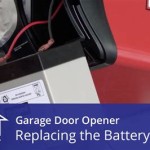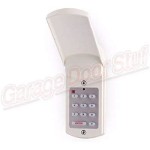Battery Replacement for Craftsman Garage Door Remote
Craftsman garage door openers are a ubiquitous feature in many households, offering convenience and security. A key component of this system is the remote control, which allows users to operate the garage door from a distance. Like any electronic device powered by batteries, the Craftsman garage door remote requires periodic battery replacement to ensure consistent and reliable performance. Understanding the process of identifying the correct battery, accessing the battery compartment, and properly replacing and testing the battery is essential for maintaining the functionality of the garage door opener.
The Craftsman brand, owned by Stanley Black & Decker, has produced various models of garage door openers and remotes over the years. While the core function of opening and closing the garage door remains consistent, the design and battery requirements of the remotes can vary slightly depending on the model. Therefore, it's crucial to consult the owner's manual for the specific remote in question to determine the correct battery type and the recommended replacement procedure. This article provides a general guide to battery replacement for Craftsman garage door remotes, but it should not supersede the instructions provided in the official documentation.
Identifying the Correct Battery Type
The first step in replacing the battery for a Craftsman garage door remote is to identify the correct battery type. Using an incorrect battery can lead to malfunction, damage to the remote, or even safety hazards. The battery type is typically indicated in the owner's manual. If the manual is unavailable, several methods can be used to determine the correct battery.
The most common battery types used in Craftsman garage door remotes are button cell batteries, also known as coin cell batteries. These are small, disc-shaped batteries that are typically made of lithium. Common sizes include CR2032, CR2025, and CR2016. The numbers in the designation indicate the battery's physical dimensions. For example, a CR2032 battery is 20mm in diameter and 3.2mm thick.
Another way to determine the correct battery type is to examine the old battery that is being replaced. Carefully remove the battery from the remote and note the markings on the battery itself. The battery type is usually printed directly on the battery's surface. If the markings are faded or illegible, try using a magnifying glass or a flashlight to get a better view.
If neither the owner's manual nor the old battery provides the necessary information, online resources can be helpful. Search for the specific model number of the Craftsman garage door remote online. Many retailers and manufacturers provide battery specifications for their products on their websites. Online forums and communities dedicated to garage door openers may also offer assistance in identifying the correct battery type.
It is also possible that some older Craftsman remotes may use smaller, cylindrical batteries like A23 or AA batteries. These are less common in newer models, but it is essential to verify the battery type before purchasing a replacement. Once the correct battery type has been identified, purchase a high-quality replacement battery from a reputable retailer. Avoid using generic or low-quality batteries, as they may not provide consistent performance or have a shorter lifespan.
Accessing and Replacing the Battery in the Remote
Once the appropriate replacement battery has been obtained, the next step involves accessing the battery compartment on the remote and replacing the old battery with the new one. The process for opening the remote varies depending on the model, but typically involves removing the battery compartment cover.
Begin by carefully examining the remote for screws or latches that secure the battery compartment cover. Some remotes have a small screw on the back that needs to be removed using a small screwdriver, usually a Phillips head screwdriver. Other remotes have a snap-fit cover that can be pried open using a small, flat-blade screwdriver or a similar tool. Exercise caution when using a screwdriver to avoid scratching or damaging the remote casing. Locate a small notch or groove where leverage can be applied to gently pry open the cover.
If the remote does not have any visible screws or latches, it may require sliding the entire remote case apart. Look for a seam or line running around the perimeter of the remote. Try gently sliding the two halves of the remote apart. If the remote does not budge easily, do not force it. Check for hidden screws or latches that may be preventing it from opening.
Once the battery compartment cover is open, carefully remove the old battery. Note the orientation of the battery before removing it. Most button cell batteries have a positive (+) side and a negative (-) side, and they need to be installed in the correct orientation for the remote to function properly. Some remotes have markings inside the battery compartment that indicate the correct battery orientation. If not, take a picture of the battery before removing it as a reference.
Install the new battery into the battery compartment, ensuring that it is oriented correctly. The positive (+) side of the battery should typically face up, but always double-check the markings inside the compartment or the picture taken earlier. Once the battery is securely in place, replace the battery compartment cover. If the cover is secured with screws, tighten them gently. If the cover is a snap-fit design, press it firmly until it clicks into place. If the remote case slides together, ensure that it is properly aligned before sliding it closed.
Testing and Troubleshooting the Remote After Battery Replacement
After replacing the battery, it's crucial to test the remote to ensure that it is functioning correctly. Stand at a safe distance from the garage door and press the remote button to activate the door opener. Observe whether the garage door opens or closes as expected. If the garage door does not respond, there may be an issue with the battery installation or the remote itself.
The first step in troubleshooting a non-functional remote is to double-check the battery orientation. Even if the battery was installed correctly initially, it may have shifted during the replacement process. Remove the battery compartment cover and verify that the positive (+) and negative (-) sides of the battery are aligned with the markings inside the compartment. Reinstall the battery and test the remote again.
If the battery orientation is correct, the next step is to check the battery voltage. A new battery should have a voltage close to its rated voltage. For example, a new CR2032 battery should have a voltage of approximately 3 volts. Use a multimeter to measure the battery voltage. If the voltage is significantly lower than the rated voltage, the battery may be defective and need to be replaced. If possible, test the remote with another new battery to confirm whether the issue is with the battery itself.
If the remote still does not work after verifying the battery orientation and voltage, the remote may need to be reprogrammed to the garage door opener. Refer to the owner's manual for instructions on how to program the remote. The programming process typically involves pressing a "learn" button on the garage door opener motor unit and then pressing the remote button to synchronize the two devices. The specific steps for programming the remote vary depending on the model of the garage door opener.
If the remote continues to malfunction after reprogramming, there may be a more serious issue with the remote or the garage door opener. Possible causes include a faulty remote circuit board, interference from other electronic devices, or a problem with the garage door opener motor unit. In such cases, it may be necessary to consult a qualified garage door technician for further assistance. They can diagnose the problem and recommend the appropriate repair or replacement.
When replacing batteries, it is important to dispose of the old batteries properly. Many municipalities have recycling programs for batteries. Contact the local waste management authority or a recycling center for information on how to dispose of batteries in a safe and environmentally responsible manner. Do not dispose of batteries in the regular trash, as they can leach harmful chemicals into the environment.
Maintaining the Craftsman garage door remote with proper battery replacement is a straightforward process that can ensure the convenience and security of the garage door system. By identifying the correct battery type, carefully replacing the battery, and testing the remote after installation, users can keep their garage door opener functioning reliably for years to come.

How To Change Battery Of Sears Craftsman Garage Door Remote Control

Change Battery In Sears Craftsman Garage Door Remote Control Replacement

Change Battery In Sears Craftsman Garage Door Remote Control Replacement

Battery Change On 971lm Remote Sears Craftsman Liftmaster Youtube

Sears Craftsman Garage Door Opener Remote Control 139 53753 Hbw2028 315mhz Ebay

Craftsman Garage Door Opener Remote Battery Change Easy Diy

1 2 For Craftsman Garage Door Opener Replacement Remote Control 41a7633 Hbw7359 Ebay

Rowyig 1 Piece Gray Garage Door Opener Enhance Your Craftsman With Battery

How To Change The Battery In Craftsman 315 Garage Door Opener Remote Youtube

Sears Craftsman 2pack 139 53681b Garage Door Opener 1btn Remote 53680 390mhz Ebay
See Also








